How can grapes be propagated?

The propagation of grapes can be done both in the spring and in the autumn. However, as practice shows, spring planting gives the best results. During this period, the seedlings take root more easily, they are not afraid of frosts, and the first crop can be harvested earlier than during autumn planting. There are several popular ways to propagate grapes, each has its own advantages and disadvantages - we'll talk about them in our review.

Propagation by cuttings
The simplest method for propagating garden grapes is by using cuttings. They can be harvested in early spring or late autumn. In the first case, this is done before the onset of the growing season and sap flow, in the second - with the arrival of the period of winter dormancy.
Autumn harvesting of planting material is considered preferable, since in spring some of the shoots are damaged by frost.
A healthy, strong vine with no external signs of damage and disease with a thickness of 8-10 mm is suitable for cuttings. It must be cut into separate shanks so that 6-8 buds are preserved on each. If you plan to harvest many cuttings at once, it is better to store the whole vine without cutting. This is due to the fact that during winter storage the places of the cuts dry out slightly, in the spring they have to be updated. Accordingly, in the course of trimming the edges, the length of the cutting is significantly reduced - the material may simply be unsuitable for subsequent rooting.
The workpieces are sorted by type, connected into bundles and sent to storage. For this, rooms with high humidity and a temperature of 2-4 degrees are suitable.
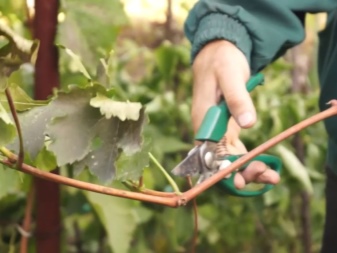

Owners of private houses do this in the basement, where the temperature and humidity indicators are as close to ideal as possible. In addition, there is enough free space in the subfield to accommodate the entire vine.
The workpieces are stored in plastic wrap, several ventilation holes must be provided in it. In winter, you need to periodically check the condition of future seedlings. If you notice that the cuttings are drying, you should sprinkle them with water from a spray bottle. If the humidity level in the basement is higher than the normalized and signs of rot appear on them, they should be removed from the film, the damaged fragments should be removed and treated with a solution of copper sulfate or Bordeaux liquid. When the blanks are dry, they are wrapped again in film, but try not to wrap them too tightly.
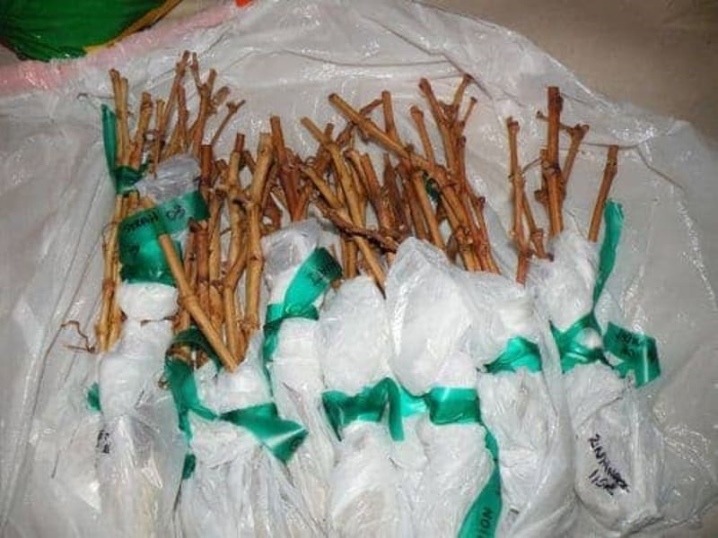
Experienced growers keep the cuttings in the sand. In this case, a layer of river sand 6–10 mm thick is poured onto the basement floor. The substrate is slightly moistened from above and the vine blanks are placed, and then sprinkled with wet sand again. Caring for cuttings is reduced to maintaining the necessary moisture in the soil.
If you do not have a basement, you can store workpieces right on the site... To do this, dig a hole in the ground 40–60 cm deep and carefully place the vine in it. To protect against frost, they cover it with an earthen mound and wrap it with spruce branches. In this form, the cuttings can survive until spring without any problems.
You can place the cuttings in the refrigerator. In this case, they should be divided into separate fragments, wrapped in a damp cloth and placed in a plastic bag with holes for ventilation. It is best to keep them on the bottom shelf of the refrigerator or in a vegetable basket. Some gardeners coat the cuttings with plasticine or melted wax - this method allows you to retain moisture to the maximum.
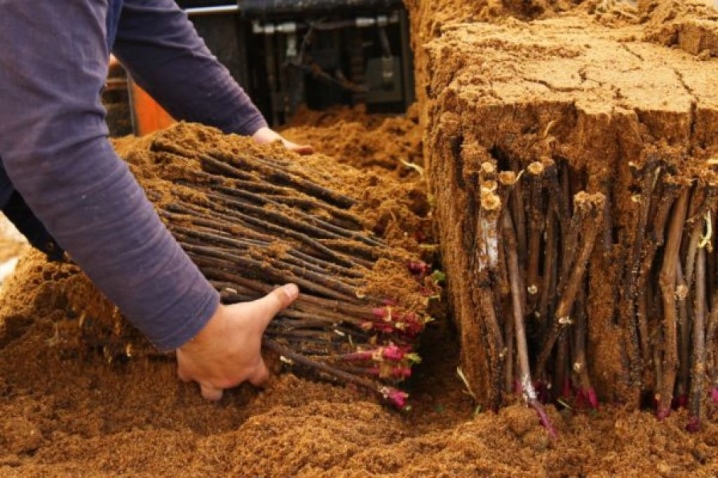
All subsequent care is reduced to periodic inspection of the cuttings and, if necessary, moistening them. In late February - early March, the blanks are removed from the film, inspected and damaged fragments are removed. Then the vine is cut into separate cuttings so that the lower cut passes under the lower bud at an angle of 90 degrees, the upper one a couple of centimeters above the upper bud at an angle of 45 degrees.
Before rooting, the material should be soaked, this procedure takes 2-3 days. For this, the workpieces are placed 2/3 of the length in table water or rainwater with a growth stimulant drug diluted in it: Kornevin, Epin or Heteroauxin. For the same purpose, you can take flower honey, it is bred in the proportion of 1 tbsp. l. on a bucket of water.
At the top of healthy blanks, drops of water will appear in the first hour. If you do not notice them even after a day, then you need to update the cut points and send the cutting back to the nutrient solution. If drops do not appear within 3 days, then the material is unsuitable for subsequent rooting.

In order for the cuttings to take root as quickly as possible, it makes sense to hold them furrowing. To do this, after soaking, the lowest kidney is cut off and several neat longitudinal cuts are made on the lower part of the cutting. It has been noticed that roots appear much faster in these places.
Prepared cuttings are placed in wet sand and wait for the roots to appear. As soon as they appear, you can send them for growing. For this, a soil mixture is prepared from forest land, humus, river sand and low-lying peat, taken in equal proportions.

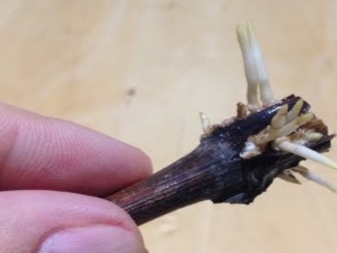
Expanded clay or any drainage should be poured onto the bottom of the container where the landing is planned. The container is filled with soil mixture by a third and placed in the center of the cutting. After that, it remains only to carefully add the earth to the top so that the uppermost kidney is above ground level.
All further care is watering. However, you need to be careful here. If there is too much water, young roots will begin to rot. Watering in a pan rather than at the root will be most effective.
When rooting grape cuttings, it is always better to underfill slightly than to moisten too much.

Starting from mid-May, rooted blanks are planted in a permanent place. So that the young plant does not experience stress from the changed temperature, the cuttings must be hardened. To do this, they are taken out into the street every day: first for an hour, then the time interval is gradually increased. Shortly before planting, cuttings should be left outdoors throughout the day.
It will not be superfluous to accustom the seedlings to the bright sun. For this, after hardening, young plants are placed in a sunny place, gradually increasing the time of exposure to ultraviolet rays. When the threat of recurrent frosts has completely passed, the prepared seedlings are placed in a permanent place.

How to plant by dropping vines?
Many fruit shrubs are planted with layering. This method involves burying shoots and branches to the ground. If the procedure is carried out correctly, several new plants can be obtained at once in one summer. This method is used for poorly rooting varieties as well as seedless varieties, it can be used for decorative girlish grapes. At the same time, the nutrition of future seedlings from the parent bush is preserved, thereby ensuring the full development and formation of its root system.
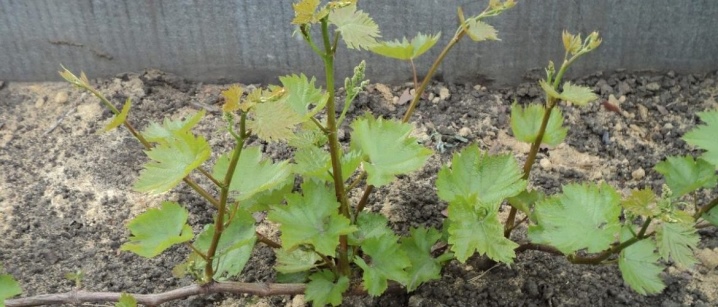
Lignified shoot
Lignified shoots are buried in April, before the onset of sap flow. For this, strong shoots of the last year, located close to the ground, are suitable. In the chosen place, they dig a trench 45 cm deep from the bush to the area where you plan to dig in the vine.
Soil is poured into this hole, fed with humus, compost and superphosphate, and then the shoot is carefully laid. You need to bend it carefully so as not to break it. At the bottom of the hole, it is fixed with wire or stone.
Where it is planned to grow a new plant, the vine is bent, then carefully taken out and fixed to a peg. After that, it is necessary to remove all buds and eyes located on the shoot from the parent grape to the bend zone. Sprinkle the trench with soil and thoroughly moisten. Usually, quite strong roots are formed in a year, and with the onset of next spring, you can painlessly separate the young plant from the parent.

Green shoot
If a grape bush has given many young shoots, then in June or July you can try to dig in the most powerful of them. The technique of work is similar and involves the removal of the upper part of the shoot with a pair of leaves. If the shoot is long, you can dig in it like a sinusoid and bring it to the surface two or more times. In this case, all areas remaining under the ground are carefully fixed in the trench with hairpins.
During rooting, it is important to prevent the soil from drying out. Compliance with agricultural technology allows you to get several young plants at once by the beginning of the next growing season.

"Chinese" taps
The name "Chinese" was given to the layers, which are formed due to the complete laying of lignified shoots in the substrate. This method is used to breed poorly rooted varieties. In this case, in early spring, the longest shoot growing at the base of the grape bush is chosen and buried along its entire length into a trench to a depth of 20–25 cm.
Sprinkle the planting material on top with a moistened substrate and pin it several times. The pit is not completely covered with earth, but in a layer of 5–6 cm. When buds appear on the branches and shoots begin to grow from them, you can add a little more earth to the ditch.
With proper care, shoots will grow in all buried buds... In this case, in the last decade of August - early September, the vine is carefully dug up and cut into several young seedlings - they can be planted on a permanent site. However, in this case, during the summer season, you will have to remove not only extra bunches, but also young shoots and all stepchildren. This will reduce the stress on the main bush, but at the same time reduce the yield.
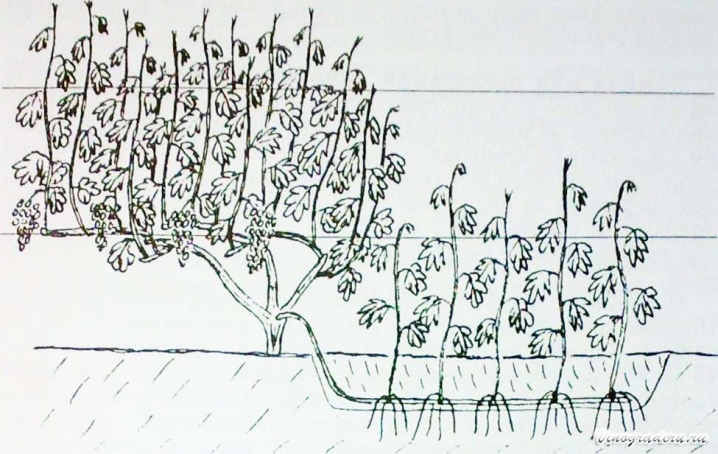
How to dilute with the vaccine?
Experienced growers use grafting to cultivate a culture. It can be carried out in different ways, while it is permissible to use cuttings harvested from young shoots of the current season, and last year. Depending on this, different terminology is used: “black to green”, “black to black”, “green to black”.
It is best to use cuttings prepared in the fall and stored in the basement as a scion.
Such a vaccination will be effective if the buds on the branches are already slightly swollen. When performing the work, the cuttings are selected in such a way that their size is suitable for the rootstock shoot. After that, the workpiece is soaked in water for 3-5 hours and oblique cuts are formed on the handle and rootstock, then the grafting zone is connected and tightly fixed.
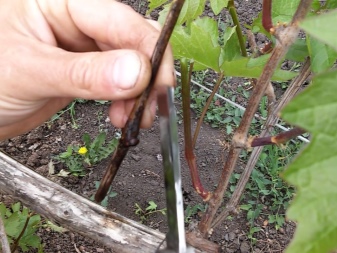
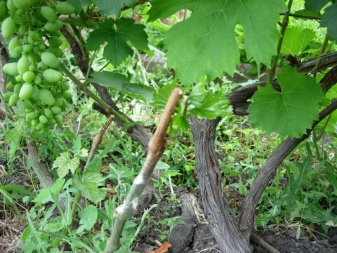
Grafting "black on green" involves the use of two-year-old cuttings with awakened buds. They are grafted onto the strong green shoots of this year. This inoculation is carried out using the “split” technique, the work can be performed throughout the entire growing season.
Kidney grafting is performed in June / July, always on a green vine. It involves the implantation of the kidney into the stock using longitudinal or T-shaped incisions. The vaccination site is wrapped with plastic wrap, and after months it will already be well established.
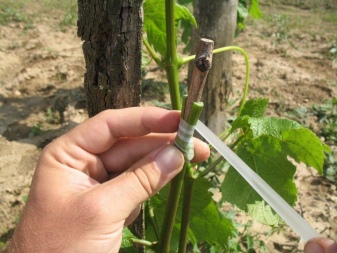
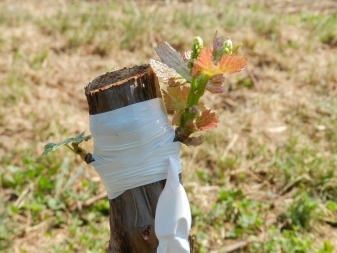
How to grow from seeds?
The seed method of propagation of grapes is very long, the first harvest will have to wait for several years. Usually, scientists resort to this method to breed new varieties.In summer cottages, it is not in demand.
Usually, seeds are planted to a depth of 2 cm, on sandy substrates - by 4 cm. The first shoots appear after one and a half to two weeks, at this moment the container with young shoots must be placed on a lighted windowsill, protected from drafts. At this stage, the seedlings need at least 15 hours of light per day, so use backlighting if necessary.
It will be useful to mulch the ground with perlite. This will prevent the development of the black leg. As soon as it gets warm, young bushes can be planted in bulky containers or open ground.
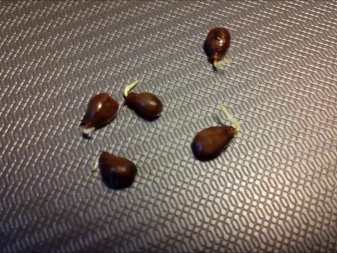

Despite the apparent complexity, Anyone who is familiar with the rules of caring for fruit and berry crops can propagate grapes... Despite the fact that garden grapes are liana, by their nature they are not much different from other fruit shrubs. Accordingly, his breeding techniques are basically the same as, for example, gooseberries and currants. You can get new plants at home by cuttings, grafting or layering. If you follow all the rules, then even beginners will be able to get high quality planting material.









The comment was sent successfully.